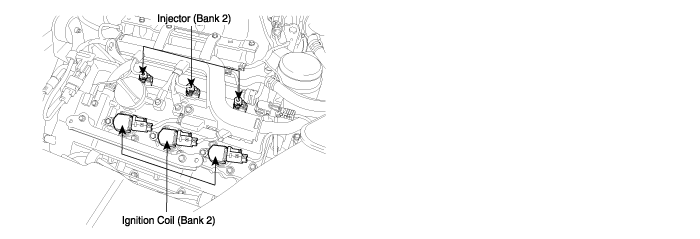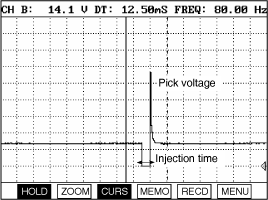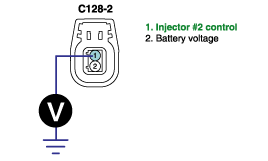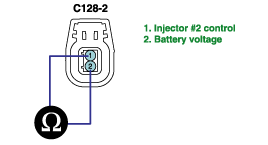Monitor "fuel injection time" item on the service data.


Electronically controlled fuel injector is a solenoid valve which supplies exactly calculated amount of fuel to engine for optimum conbustion under various engine load and speed. To meat air-fuel ratio required in system, PCM regulates fuel injection quantity as controlling injector solenoid operating duration referring air flow to cylinders and output signals from HO2S. For this precise control, quick response of solenoid is required and for perfect combustion, injection characteristic is important.
Checking output signals from injectors. Under detecting condition, if an output signal is high, PCM sets P0265. MIL(Malfunction Indication Lamp) turns on when the malfunction lasts till consecutive 2 driving cycle.
Item | Detecting Condition | Possible Cause | ||||||
DTC Strategy | ● Signal High | ● Poor connection ● Short to battery in harness ● Injector ● PCM | ||||||
Enable condition | ● Engine running state ● 11V ≤ Battery voltage ≤ 16V ● Above conditions are met 〉0.5sec. ● No disabling faults present | |||||||
threshold value | ● Short to battery | |||||||
diagnosis time | ● Continuous | |||||||
MIL ON condition | ● 2 driving cycles | |||||||

When the PCM energizes the injector by grounding control circuit, the circuit voltage should be low (theoretically 0V) and the fuel is injected. When the PCM de-energizes the injector by opening control circuit, the fuel injector is closed and circuit voltage should be peak at a moment.
Item | Coil resistance(Ω) | ||||
Injector | 11.4 ~ 12.6Ω ( at 20℃/ 68℉) |

IG "OFF" & connect scantool.
ENG "ON" and warm -up the engine to normal operating temperature.
Monitor "fuel injection time" item on the service data.

Is the service data displayed correctly ?

▶ Fault is intermittent caused by poor contact in the sensor’s and/or PCM’s connector or was repaired and PCM memory was not cleared. Thoroughly check connectors for looseness, poor connection, ending, corrosion, contamination, deterioration, or damage. Repair or replace as necessary and go to "Verification of Vehicle Repair" procedure

▶ Go to "Terminal and connector inspection" procedure
Many malfunctions in the electrical system are caused by poor harness and terminals. Faults can also be caused by interference from other electrical systems, and mechanical or chemical damage.
Thoroughly check connectors for looseness, poor connection, bending, corrosion, contamination, deterioration, or damage.
Has a problem been found?

▶ Repair as necessary and go to "Verification of Vehicle Repair" procedure

▶ Go to "Control Circuit Inspection" procedure.
Check voltage
IG "OFF" and disconnect injector connector.
IG "ON" and ENG "OFF"
Measure voltage between terminal 1 of injector harness connector and chassis ground.
Specification : Approx. 0V

Is the measured voltage within specification?

▶ Go to "Component Inspection" procedure.

▶ Go to "Check short to battery in harness" as follows.
Check short to battery in harness
IG "OFF" and disconnect injector connector and PCM connector.
Measure resistance between terminals 1 and 2 of injector harness connector.
Specification : Below 1Ω

Is the measured resistance within specification?

▶ Go to "Component Inspection" procedure.

▶ Repair short to battery in harness, and go to "Verification of Vehicle Repair" procedure.
Check injector
IG "OFF" and disconnect injector connector.
Measure resistance between terminals 1 and 2 of injector connector.(Component side)
Item | Coil resistance(Ω) | ||||
Injector | 11.4 ~ 12.6Ω ( at 20℃/ 68℉) |

Is the measured resistance within specification?

▶ Substitute with a known - good PCM and check for proper operation. If the problem is corrected, replace PCM and go to "Verification of Vehicle Repair" procedure.

▶ Substitute with a known - good injector and check for proper operation. If the problem is corrected, replace injector and go to "Verification of Vehicle Repair" procedure.
There is a memory reset function on scantool that can erase optional parts automatically detected and memorized by PCM. After testing PCM on the vehicle, use this function to reuse the PCM on the others
After a repair, it is essential to verify that the fault has been corrected.
Monitor and record the Freeze Frame Data for the Diagnostic Trouble Code(DTC) which has been diagnosed.
Using a Scantool, Clear the DTCs
Operate the vehicle within conditions noted in the freeze frame data or enable conditions
Monitor that all rediness test have been verified as " Complete "
Are any DTCs present ?

▶ Go to the applicable troubleshoooting procedure.

▶ System is performing to specification at this time.